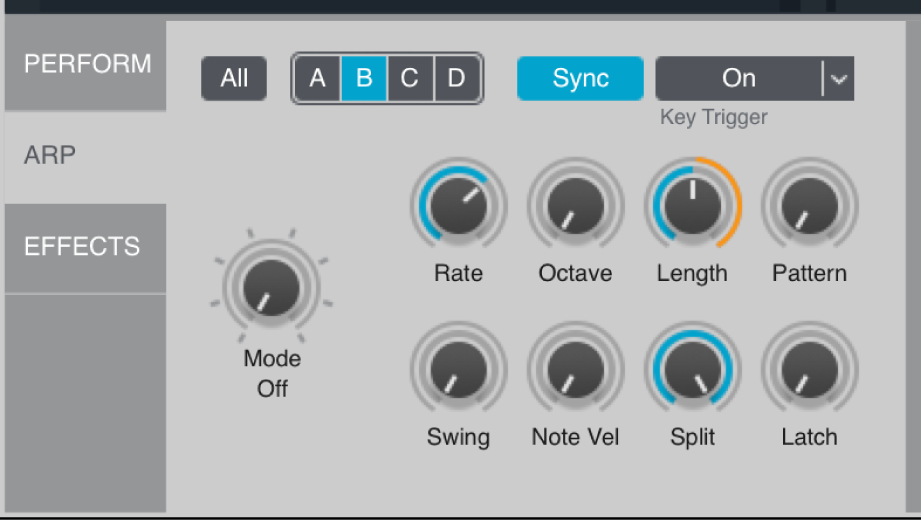
Alchemy basic arpeggiator controls in MainStage
The arpeggiator is shown only in browse or advanced view. Click the Browse or Advanced button to switch to either view, then click the Arp button in the Perform/Arp/Effects section.
The basic arpeggiator controls consist of several buttons and nine knobs.

Basic arpeggiator controls
All/A/B/C/D buttons: Choose the target source that is used to play the arpeggiator pattern. See the tasks in Use the Alchemy arpeggiator in MainStage.
When set to All, the arpeggiator pattern is played by all active sources.
You can restrict the arpeggiator pattern to a single target source by setting values for one of the A, B, C, or D arpeggiators. The other three sources, if active, respond to incoming MIDI data with no arpeggiation.
You can also activate and create different arpeggio patterns for any combination of the A, B, C, or D arpeggiators. When you play the keyboard, each active source is triggered by the corresponding active arpeggiator, resulting in up to four simultaneous (but different) arpeggiated sources.
Note: Alchemy uses separate voices to play arpeggiated and non-arpeggiated output. Therefore, this feature requires the Num(ber) of voices to be set to at least 2 in the master voice section. See Alchemy master voice section in MainStage.
Sync button: Turn on to synchronize the arpeggiator with the project tempo. See Rate knob.
Key Trigger pop-up menu: Choose an option to align the arpeggiator and host application grid values. Incoming and playing notes snap to this value when the host is in play mode.
Choose a value other than Off to restart the arpeggiator pattern when the first note is struck after a pause. This allows you to create pattern variations by playing chords on different beats in the bar and may feel more responsive. Playing legato does not retrigger the arpeggiator.
Choose Snap to Rate when you want to use a host application rate that differs from available menu options.
Choose Cycle Reset to enable or disable. This option starts the arpeggiation from the first note each time the pattern is repeated and when the host application is started (at step 1). Cycle Reset is enabled by default, and turned off for all existing presets for backwards compatibility.
Mode knob: Turn the arpeggiator on and off, and determine the order in which incoming notes are organized into a pattern. In addition to Off, you have the following choices:
Up: Plays the current notes from lowest to highest.
Down: Plays the current notes from highest to lowest.
Up/Down: Plays the current notes from lowest to highest and back again.
Down/Up: Plays the current notes from highest to lowest and back again.
As Played: Plays the current notes in the order they were originally played.
Random: Plays the current notes in a random, non-repeating order.
Chord: Plays all held notes simultaneously as a chord. The chords are retriggered and pulse in time with the arpeggiator rate and rhythm, as determined by the arpeggiator sequencer settings. See Alchemy arpeggiator sequencer in MainStage.
Note: Mode is a modulation target. This lets you set a Perform knob to modulate Mode, enabling you to turn the arpeggiator on and off during a performance.
Rate knob: Set the duration of each arpeggiator step. When Sync is on the arpeggiator is synchronized with the project tempo, and Rate is set in bars/beats. When Sync is off, the Rate knob sets a constant length for each step which is unaffected by project tempo changes.
Octave knob: Determine if the arpeggiator pattern is played only at its original pitch or across higher octaves when the pattern is repeated.
Length knob: Set the length of each arpeggiated note. At the maximum setting of 100% the length of each note is a full step. Set the length to lower values to generate shorter notes for a more staccato effect (if triggering a sound with a fast release time).
Pattern knob: Choose the active pattern in the step sequencer section to the right. Sixteen different step sequencer patterns can be created and edited for each arpeggiator. By default, all patterns are identical, so this parameter has no effect until your patterns are edited.
Swing knob: Change the timing of the arpeggiator, moving even-numbered steps to later positions without changing the timing of odd-numbered steps. This can add a more relaxed feel or groove to the part. Swing generally works best when combined with a Rate knob setting of 1/4 of a beat (16th note swing feel) or a Rate knob setting of 1/2 a beat (8th note swing).
Note Vel knob: Determine how the arpeggiator handles note velocity values. Arp sequencer 1 modulates arpeggiator Amp values by default. When Note Vel is set to a value of 0%, the step values of Arp sequencer 1 determine the velocities of notes in the arpeggiator pattern. When Note Vel is set to a value of 100%, arpeggiator pattern note velocities are determined by incoming MIDI velocities. Intermediate Note Vel values blend the Arp sequencer step values with incoming MIDI velocities.
Split knob: Set the highest MIDI note number to be included in the arpeggiator pattern. Notes above this value are not arpeggiated. Set to the maximum value (G8) to arpeggiate all MIDI input.
Latch knob: Hold the arpeggiator pattern when you lift your hands from the keyboard in Hold or Add mode. Set to Off to stop the arpeggiator pattern when you lift your hands.
Hold: Newly played notes are organized into a new pattern, which replaces the existing pattern.
Add: Newly played notes are added to the existing pattern.
Tip: Try combining As Played mode with the Add latch setting to create an interactive step sequencer with up to 128 steps.